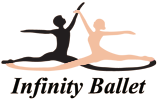At Infinity Ballet dancing “en pointe” is one of the goals for the dancer that would like to perform “classical style” ballets. It takes patience, practice and determination to achieve the strength to execute dancing en pointe safely. At Infinity Ballet it is not a requirement for all dance students training in ballet to practice pointe work unless they have the express desire to. A dancer can still achieve a high level of expertise in dance without ever dancing “en Pointe”.
There are several factors Infinity Ballet abides by in training a dancer “en pointe”:
-
- Age and Years of Training for Pointe work
The proper age to start beginner pointe work is determined by the core strength of the dancer, their understanding of how to use that strength as they train and their ability to take off and land simple classical dance jumps correctly. At Infinity Ballet we begin to consider this for dancers who are age ten and older that have been consistently taking three or more full ballet lessons per week for a full season and show these strengths.
We invite new students to try a complimentary lesson with one of our classical ballet instructors at Infinity Ballet so we can recommend a proper level for you.
-
- Class Enrollment for Pointe
All our Pointe training classes take place at the end of a ballet lesson to ensure that proper warm-up has been achieved. Classes begin with pre-pointe work of 15 minutes at the end of one lesson per week and progresses to half hour. This gradually develops through the students training until they are able to dance a full hour lesson on pointe to prepare them for performing.
-
- Physical Readiness for Pointe
All dancers who would like to dance on pointe are formally evaluated by their Infinity Ballet’s Director to determine if they are physically ready to meet the demands of pointe work. The evaluation checks for correct body position and alignment, sufficient turnout, strength and balance, and level of mastery of basic ballet techniques.
-
- Emotional Maturity for Pointe
Training for dancing on pointe requires commitment and often reserved for the most serious of ballet students. However the feeling of accomplishment and personal achievement for the dancer that loves to work hard will outweigh the occasional discomfort that comes from learning the art of classical dance.
-
- Attire for Pointe
Pointe shoes are complicated and demand a certain level of responsibility to be fit correctly as well as to maintain. You must be taught the correct way to have your shoes fit and how to put them on your feet and tie the ribbons correctly around your ankle. You must also care for them properly to keep them in good condition. IBC teachers will help you to learn what is best for you.
